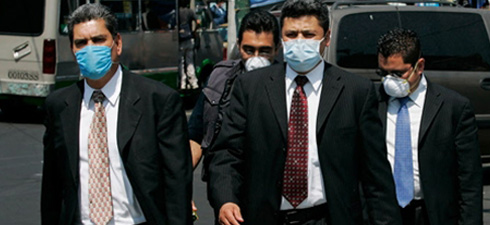How much will swine flu cost? And how can those costs be reduced? Conventional disease cost-evaluation strategies focus on two factors. First of all, "direct" costs incurred for caregivers treating patients: doctor's visits, prescription drugs, hospital stays. These costs depend on the number of cases of a disease, and how serious they are. Secondly, "indirect" costs, which are a function of the disease itself: loss of productivity due to sick leave or early death and, more difficult to estimate, losses of well-being, the consequence of the suffering endured by people who are infected. For many diseases, this model is an effective approach to evaluating costs as a whole.
If it sufficed to calculate spending on administering vaccinations, the evaluation would be fairly simple. But prevention costs must also encompass losses due to the modification of individual behaviour in reaction to fear of the disease. During an epidemic, although actual cases may be few, the public may quickly and massively overreact, and panic can have serious consequences for the health of the economy.
The 2003 SARS epidemic (Severe Acute Respiratory Syndrome) which hit many Asian countries and struck a glancing blow at Canada is instructive. The WHO estimated that, in the end, 8,096 people were infected, with 774 lethal cases. Both direct and indirect SARS costs were negligible, on the scale of the economies of the countries concerned. However, fear of the disease, fed by rumours which were often unfounded, had a serious impact on individual behaviour: nearly 10% of the population of Beijing fled the city; tourist attractions, exhibitions, and luxury hotels lost 80% of their business; and public transit companies, travel agencies, and restaurants reported losses of between 10 and 50%. In the countries that were affected the most (Hong Kong, Singapore, and Taiwan), this sharp drop in the demand for services led to a reduction in productivity estimated at between 1 and 2% of GDP.
The story will not be exactly the same with swine flu. Nevertheless, there is no doubt that in a few weeks – perhaps by September – H1N1 will return to the northern hemisphere countries. And that's when individuals will begin doing their utmost to avoid infection, even if this means being overly careful. Companies will probably set their "business continuation plans" in motion, asking employees to work from home instead of at the office; recreational and business travel plans will be cancelled or delayed; public transport will be deserted, and personal vehicles deployed; concert halls, theatres, art galleries, cinemas and restaurants will be emptied. In other words, even though the number of serious cases may be relatively limited, chaotic individual reactions are likely to throw a spanner into the economic works and cause a serious downturn in productivity. In fact, the troubles looming may curtail investment and lead to seismic shifts in international capital: the Mexican peso has already plummeted.
Panic-driven behaviour can doubtless be avoided, especially if objective information is readily available and transparent. Nothing should be hidden; nothing should be exaggerated: official information about the epidemic must be credible. If not, ill founded rumours or excessively fearful, mimetic behaviour could turn an epidemic of little consequence into yet another crisis to be added to the existing one.
STATISTICS
10,650 cases in Europe
The arrival of "the first pandemic of the 21st century" is now official. Having already declared all of humanity "under threat" in April, WHO director-general Margaret Chan raised the swine-flu threat awareness level to 6 on June 11, as virus H1N1 continued to spread. The EU's European Centre for Disease Prevention and Control, located in Stockholm, released a statement that 10,649 cases of influenza A had been confirmed. In Britain, the European country with the highest number of cases, the National Health Service (NHS) reports 29 deaths caused by the virus. Worldwide, there have been a total of 589. The British Department of Health estimates that if current trends continue, the country might face 100,000 new flu cases per day at the end of August. These predictions have economists wondering about the economic impact of the pandemic. In a study published 17 July, the British consultancy Oxford Economics suggested that the disease might postpone global economic recovery for another one or two years, Le Monde reports.
Was this article useful? If so we are delighted!
It is freely available because we believe that the right to free and independent information is essential for democracy. But this right is not guaranteed forever, and independence comes at a cost. We need your support in order to continue publishing independent, multilingual news for all Europeans.
Discover our subscription offers and their exclusive benefits and become a member of our community now!












